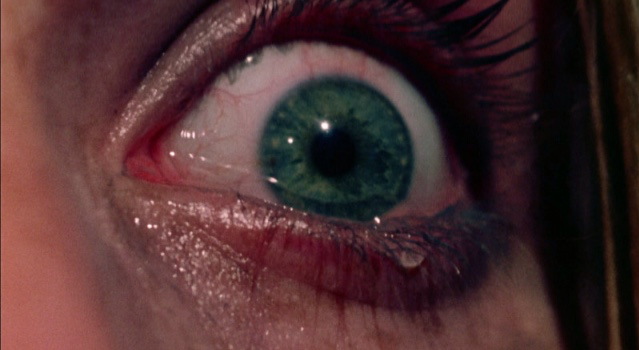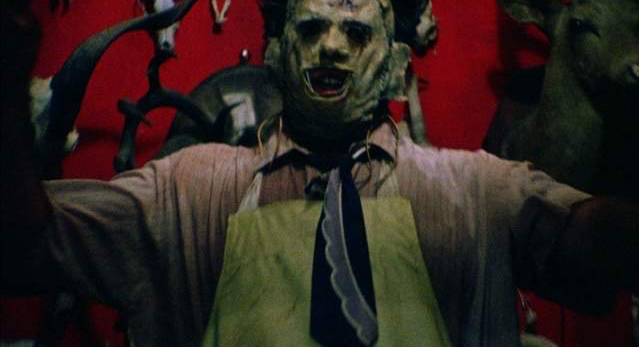Happy Halloween: The Texas Chainsaw Massacre
(40th Anniversary of a genuine, true art-house, horror classic!)

Now it begins…Aleister Crowley died in 1947…The Texas Chainsaw Massacre premiered in 1974…just months prior, in 1973, over-the-counter ‘cough syrup’ (more importantly the psychedelic-dissociative) Romilar made it’s ‘final bow’ from pharmacy shelves and ’70s teenagers everywhere mourned…but a new Aeon was in bloom; as the character, Pam, in The Texas Chainsaw Massacre says: “[in the summer of 1974] Saturn is in Retrograde!” Saturn, in astrology is the King of Karma and retrograde is Karma meted out…so indeed, something wicked this way comes…
Of course, The Texas Chainsaw Massacre, right?
But…
Why ‘art-house’ film?
Because, quite sincerely, in my opinion: The Texas Chainsaw Massacre, is and always has been, more than a horror film…though it’s that too! But, the film transcends the genre and that label. I truly find it to be an ‘art film’ of the most visceral variety.

The film resides in the Museum of Modern Art’s film archives and is lauded by such esteemed filmmakers (as far afield) as: Steven Spielberg and William Friedkin. I don’t know of one modern experimental/noise musician/artist who hasn’t cited the film’s score as an “influence” on their work. I can hear shades of the soundtrack in songs like “Hamburger Lady” by Throbbing Gristle and much of the early British power-electronics scene. But it’s not just because of the above facts, but oh so much more, that it’s clear to me the film has much more to express and offer than just really good “shock-horror”…though it has that too!
In my opinion, The Texas Chainsaw Massacre, is a film that’s more than the sum of it’s parts. In fact, It’s described by the film’s editor and director’s assistant Sallye Richardson as ‘being born’ when they finished the absolute final mix of the film. She states* “I got scared, I got really scared, because it became something other than what it was, it went to another dimension, it was like a spirit went into it, it became that entity that people now look at. A spirit went into that thing–it wasn’t always there, but after [the final mix] it was always there…it was that magical thing, it wasn’t just a piece of film any more–that’s when I got scared.” I can’t think of a better way of describing the brilliance of this film. It can’t be codified and any attempts to explain what makes it so effective and ‘genius’ falls apart in your hands, disintegrates before you can get a grip on it…the film is ineffable, one cannot ‘pin it down’. There’s something intrinsic to the film, perhaps there’s something ‘in’ the celluloid, as Sallye Richardson alludes to? It can’t fully be explained and I won’t even try.
I’ve stated on many occasions (and still maintain) that the Texas Chainsaw Massacre is “the best American film ever made”** not the best American “horror film” ever made, no, the best American film ever made…period! I usually avoid even naming “favorite films”, I don’t even like to compare favorite films…but the Texas Chainsaw Massacre, for some strange reason, I feel I can safely say, is my favorite American film! The film is SO quintessentially “American” too. It personifies just about everything American one can think of: the break-up of the family unit, barbecue, ‘mom and pop jobs’ squashed by ‘big corporations’, youth culture, taxidermy and most importantly chainsaws!
The film has something about it that cannot be ”re-created” either. Lord knows “they’ve” tried! The number of sequels and remakes alone, make this pretty clear. The film gives people the impression it would be ‘easy’ to tap into. It seems deceptively simple to recreate…but it’s not…many have tried, all have failed. Even the director of the Texas Chainsaw Massacre, Tobe Hooper, could never recreate that same level of cinematic genius. I firmly believe it’s a film that could only have been created at that time, could only exist at that particular period in history. Ironically, the film never seems ‘dated’. It exists inside it’s own universe, a universe that reflects the real world, but is distinctly separate from it. It’s what I believe the best films all contain, to one extent or another. The film also seemed to have spilled forth directly from Tobe Hooper’s “Id”, which is what makes it the ‘art-house/horror film’ I believe it to be. It’s also what makes it look like a beautiful piece of surreal art and a disciplined crafting of pure Id. I don’t think Hooper himself could tell you why the film works as well as it does? Could it be that it was created by a group of young Austin filmmakers, artists and performers heroically charged with mega-doses of enthusiasm who all wanted to help create the best low budget movie that they could? Well, we could explore all these elements and I could write about them all, but I think it would ultimately be a fool’s errand. Clearly, it’s not any of those things, neither individually nor combined, that make this film the genius work of art that it is. Plenty of other films have contained the same or similar ‘elements’ but did not produce an end product anywhere near the kind of final results we see from The Texas Chainsaw Massacre.
The essential plot of The Texas Chainsaw Massacre is ridiculously simple (a group of young people travel to an unfamiliar locale and are killed off by a family of cannibals…that’s it! That’s the extent of the ‘plot’) as I said already, this is a film that’s far more than the sum total of it’s parts. In fact the ‘simplistic plot’, I think, helps make the rest of the film come to life and move to the fore as graphically and creatively as it does. There’s a vast amount of information, data and details packed densely, yet economically, into this rather paltry plot of a horror film. It does everything a good film is supposed to do. It puts you, the viewer, into the place of the protagonists. Makes you feel what they feel, brings their fear and terror directly to you…but subtly. It doesn’t beat you over the head (pun fully intended) with what it’s trying to express. In fact many a modern filmmaker could learn a lot from this little low budget film from Austin, Texas.

A perfect example of what I’m talking about is when the first victim in the film steps into the decrepit ‘old house’. He stumbles, tripping, through a doorway with a blood red wall covered with horns, antlers, animal skulls, pelts and other bits of odd deathly detritus behind it. The sound of a pig squealing can be heard among the rattling of animal bones that hang from the ceiling, like primitive ghastly mobiles. Then, suddenly and without warning, a big hulking ‘humanoid’ wearing another person’s face for a mask and a bloodied butcher’s apron, just appears from behind and stands, looming, before him. A low guttural pig’s squeal is heard once again and “It” raises it’s hand-held sledge hammer, brings it down on the young man’s skull and cracks it. The body drops to the floor and lays in the doorway, shaking, twitching and convulsing…the hulking thing drags the rest of the young man’s body inside his lair and slams the sliding metal door closed with a metallic ‘kelang!’ and a harsh, dissonant musical chord thunders across the soundtrack at the same time. It’s the only bit of music in the entire scene, which expertly serves to heighten the mood and add to the creepy, stomach churning fear and anxiety of the scene. It’s brilliantly executed! Young filmmakers could learn an important lesson from this one scene alone…restraint! Restraint, which is sorely lacking from most films today.
The last scene of the film is another example of exactly why the film is sheer genius! I defy anybody to deny that Marilyn Burns doesn’t look like she has, quite literally, lost her mind while she sits, crouching and clutching manically for something to hold onto, screaming her head off in the back of that pick-up truck, as it drives her away to safety and away from the bizarre horrors she’s just endured. Leaving Leatherface, with his chainsaw swirling about in the air like a child throwing a temper tantrum, a shamanic dance in the dawn’s early light. But, it’s that look on Burns’ face in the last scene that proves to me the film exceeds it’s meager limitations and achieves a level of transcendence (?) that seems, to me, beyond B-film, beyond exploitation, beyond horror…beyond acting. It’s like: This isn’t a film “…this is really happening!”

It is said, and I believe it to be true, that it’s a miracle any films get finished at all. After one factors in all the problems that can and do arise while making a film, it’s truly miraculous that one can even complete a film! Let alone create a masterpiece like this…
Happy Halloween…one and all!
*from “The Texas Chainsaw Massacre Companion” by Stefan Jaworzyn, an absolutely excellent source for all things TCM related.
**of course I’m being slightly hyperbolic, but I’d certainly say TCM is the best film of the second half of the 20th Century!

